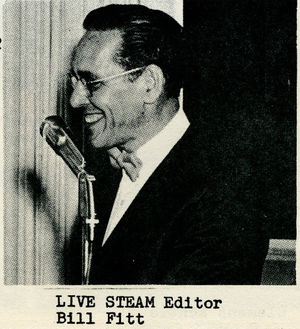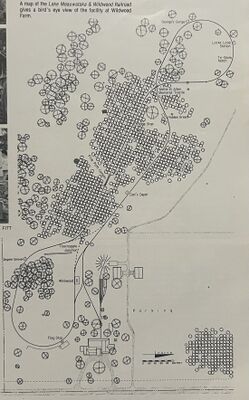William Fitt
Jump to navigation
Jump to search
Magazines
Books
Meauwataka & Wildwood Railroad
Bill Fitt, as editor and publisher of Modeltec, wrote the following in the May 1984 edition:
- Gold Spikes are a long time in becoming reality. For the Union Pacific-Central Pacific, it took six years and four months to the day from ground-breaking ceremonies to completion. For the Lake Meauwataka & Wildwood, it took sixteen years, two-and-a-half months. The Union Pacific-Central Pacific laid 1867 miles of track; the LM&W has about 3400 feet.
- In both cases, the thinking, dreaming and planning took much more time than the actual construction. For the LM&W, the Gold Spike was the culmination of a dream that began in mid-July of 1937 when Horace Shaw, one of the pioneers in inch-and-a-half scale Live Steam, turned over the throttle of his 4-6-2 to young Bill Fitt. The Live Steam Bug bit right then and there and has never relaxed its hold!
- Horace's Whysall Light Railway in Bloomfield Hills, Michigan had about 1200 feet of track that ran from Woodward Avenue back along his property line for a ways before swinging off to the opposite side of his property, down a hill, across a little creek at the bottom of a valley and then back up the other side of the valley to the North property line again. It was an out-and-back operation: running backwards on the "out" run and heading back, locomotive-first, on the return trip. Part way down the hill on the first return run, a cow meandered across the track just ahead of the engine and slowed us enough to cause a stall on the up-grade.
Leo Myers of Clayton, Missouri, describes the hammer made from a staybolt from the General of Civil War fame in the photo at right. Doris Fitt, Leo Myers, and Bill Fitt at the Golden Spike ceremony of the Meauwataka & Wildwood Railroad, October 1983. Paul Allen is seen on the trestle. Photo by Steve Chromik.
Last Meet
John Atkinson wrote, November 2025:
- I found some pictures of Bill Fitt’s track before it was dismantled and a flyer addressed to Tri-State Locomotive Club. The crossed out trestle with center bridge appears to have been spoken for after the flyer was printed. One of the photos shows how rail was attached to ties, including a concrete tie.
Riverside & Great Northern
In 1988, a group of volunteers led by William C. Fitt formed the Riverside & Great Northern Preservation Society, Inc. and went to work to save the Sandley Works by turning it into a museum.




